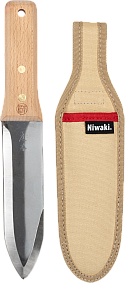
Niwaki Hori Hori Pro
$42.50 exVAT
Extraordinarily beautiful and remarkably sophisticated kitchen knives from this young blacksmith in Sanjo City, Niigata. Polished SLD steel blades, charred chestnut handles, resin ferrules. SLD steel from Hitachi benefits from a high carbon content that holds its edge well, is tough, easy to sharpen and maintain, and with a 12% chromium content is very nearly stainless. It’s laminated to an outer cladding of SUS stainless steel, polished to a mirror finish.
Gyuto is the classic chef’s knife - although Masashi makes his a tad deeper than some, more like a Santoku. Use Nakiri for veg, the deeper bladed Kamagata as a great smaller sized knife - perfect if you’re uncomfortable with larger blades - and the Petty for paring and fine work.
See Masashi at work in the video clip (scroll down), working on the tang of a knife
Delivering to US (Paying in USD)
Please note: By law, we are not permitted to sell a knife or blade to any person under the age of 18. By placing an order for one of these items you are declaring that you are 18 years of age or over. These items must be used responsibly and appropriately.
Masashi Yamamoto trained under his uncle, Yoshida san at Yoshikane, and produces knives of stunning quality - primarily in his signature SLD steel, a hard wearing, very-nearly-stainless-steel. In 2018 Masashi moved his forge to a new factory in Sanjo (in Niigata Prefecture) and now has two apprentices working with him.
We think he looks a little like Christopher Walken, and he claims to be a children’s ski instructor - something we don’t doubt.
For better or worse, Western knives are often seen as general purpose kitchen tools, used for cutting, prising, levering and all sorts of other jobs around the kitchen (and sometimes beyond).
Japanese knives should not be viewed this way and it may require a change of mindset to get the best out of your knife and ensure it delivers many years of service.
Cared for correctly, this ought to be the case: the quality of the craftsmanship and the ease with which they can be kept incredibly sharp are two of the main reasons to make the switch to Japanese steel, but that comes at a price: the steel –especially steel with high carbon content - may be more brittle than you are used to and they are not for the heavy-handed or the careless. They are unforgiving tools and you may not get an opportunity to make the same mistake twice.
A good rule of thumb is to show them the same respect you show your poshest wine glasses, but here are some other pointers.